CPUC Energy Efficiency Primer Sunday November 1 2020

CPUC Energy Efficiency Primer Sunday, November 1, 2020 Energy Division California Public Utilities Commission (CPUC)

Presentation Outline 1 • Overview of CPUC Regulation 2 • Cost-Effectiveness 3 • Energy Efficiency Goals 4 • Shareholder Incentives 5 • Ex Ante/ Ex Post 6 • EM&V 7 • Strategic Plan 8 • Energy Division Organizational Chart 9 • Appendices 2

CPUC Regulation 3

The gap between U. S. and CA energy use can be partially attributed to EE. 4

The gap between U. S. and CA energy use can be partially attributed to Energy Efficiency 5

What are the Energy Efficiency accomplishments? Evaluated Cumulative Savings from 2004 -2009 GWh saved 7387 MMTherms saved 96 MW offset 1314 Number of households powered 769, 500 Number of power plants avoided 3 Average household assumed to use 9600 k. Wh/yr; Major power plant defined to be 400 MW or greater Source: 2009 Energy Efficiency Evaluation Reports 6

Energy Efficiency is California’s Preferred Resource “Loading Order” of Energy Resources • Energy efficiency and Demand response • Renewable generation • Distributed generation • Cleanest available fossil resources West Coast Green 7

AB 32: California’s Greenhouse Gas Emission Reduction Strategies Source: California Air Resources Board Scoping Plan, December 2008, Table 2. 8

CPUC’s Approach to Energy Efficiency Value energy efficiency as a procurement resource • PUC Sec 454. 5 requires that IOUs “meet unmet resource needs with all available EE and demand reduction that is costeffective, reliable, and feasible. ” and requires CPUC to establish targets for the IOUs to achieve all cost-effective electric / gas EE • CPUC evaluates savings impacts Support market transformation of the EE industry • CA Strategic Plan—collaborative statewide effort to identify market barriers and develop cross-industry solutions • Establish program design requirements for EE portfolio 9

CPUC policy emphasis focused on voluntary market Historical Agency Emphasis / Mandates Example IOU Programs 10

Key IOU Program Design Requirements / Incentives “Sticks”: Legislative Requirements • Portfolio budgets must be reviewed and approved by Commission • IOUs must meet energy savings goals • Portfolio must be cost effective • Programs must meet the requirements of the portfolio guidance decision and pursue Strategic Plan objectives • 20% of budget must be competitively bid by third party implementers “Carrots”: Utility Benefits • Efficiency Savings and Performance Incentive (ESPI) • IOUs get other “passive” benefits from EE programs (e. g. , GHG, corporate “green-washing, ” customer satisfaction, etc. ) 11

CA Power Plant Capacity Increased by only 2/3 the National Pace in the Past 20 Years Location 1990 # of Generators 1990 Nameplate capacity (MW) 2010 # of generators 2010 Nameplate capacity (MW) Percent capacity change California 739 55, 026 803 72, 570 31. 9% United States 5318 783, 012 6, 417 1, 138, 638 45. 4% Source: U. S. Energy Information Administration, see http: //www. eia. gov/electricity/data/state/ 12

CPUC Process for Approval / Oversight of IOU EE Programs Current 2 -3 year Budget Cycle Process: -CPUC Policy Guidance -IOU Savings Goals Ex Ante Review Process -CPUC EM&V -Evaluated Savings -IOU Portfolio Applications -Projected Portfolio Savings -IOU Portfolio Implementation -Reported Savings *Phase II of R. 13 -11 -005 will consider moving away from the 2 -3 year cycle to a Rolling Portfolio framework 13

Approval and Implementation Process for CPUC Energy Efficiency Programs 1 Assessment and Analysis Staff Consultants 3 2 Guidance Decision CPUC Portfolio Development Utilities Third Parties Local Govts 6 4 5 Portfolio Adoption Implementation Utilities Third Parties Local Govts CPUC Feedback to next Cycle Incentive Payments 7 14

EE Program Characteristics* By Delivery Statewide Third Party Gov't Partnerships RENs/CCA Local IOU Total Budget ($M) 1, 166 Savings (GWh) 2, 027 538 1, 408 252 75 267 98 13 2 2, 044 3, 802 Budget ($M) 304 Savings (GWh) 679 By Sector 265 Government Partnerships Lighting Programs Financing Programs HVAC Plug-Load and Appliances Energy Advisor Program Whole House Program RENs and CCAs Non-Residential Deemed Incentives Workforce Education & Training Emerging Technologies New Construction Codes and Standards Direct Install Multi-Family Rebates Continuous Energy Improvement Marketing, Outreach, & Education IDSM By Program Third Party Programs Non-Residential Custom Projects Total Agricultural Budget ($M) 79 Savings (GWh) 248 647 Commercial 510 1, 112 256 228 267 890 211 328 487 571 190 140 104 100 80 75 109 221 229 295 25 98 Industrial Residential Gov’t Partnerships Cross Cutting Total 256 585 267 1, 019 1969 3704 64 224 63 39 35 28 21 17 7 0 6 870 41 62 14 0 14 8 2045 0 0 4670 *Data from 2013 -14 Portfolio Applications. Approved budget was reduced by $200 million. Source: 2013 IOUs Compliance Filings 15

How EE planning studies inform the next portfolio cycle EM&V Studies for the current portfolio Market Studies to determine how much EE is already installed EE measure costs Impact Studies to determine how much EE was installed in this cycle and to improve ex ante parameters Databases & Calculators to build the next portfolio Cost Effectiveness Calculator (E 3) Calculates the avoided cost for each measure, program, and portfolio Database of Energy Efficient Resources (DEER) Integrates past evaluation results and new data with model simulations to determine savings, cost, expected life for each measure Potential, Goals & Targets Calculates projected savings for each measure, sector and IOU and sums for total EE potential Portfolio Forecasting and Planning IOU Portfolio Filing Integrated Energy Policy Report Demand Forecast Long Term Procurement Planning 16

2013 -14 EE Portfolio Organization Source: 2013 IOUs Compliance Filings 17

2013 -14 EE Portfolio Organization 2, 000 78 71 4 1, 893 RENs CCA Total 217 1, 800 355 1, 600 1, 400 1, 200 1, 167 Budget ($ Million) 1, 000 800 600 400 200 IOU Statewide Programs IOU Third Party Programs Source: 2013 IOUs Compliance Filings IOU Government Partnerships EM&V 18

2013 EE Incentives and Gross Savings by End-Use 38% Total Incentives ($) 26% 45% Gross k. Wh/yr 11% 40% Gross k. W/yr Gross therm/yr -20% -40% -20% Lighting Source: 2013 IOUs Compliance Filings HVAC 20% Process Whole. House 8% 14% 49% 0% 10% 33% 40% Refg. Frzr 60% 6% 9% 5% 4% 16% 6% 9% 13% 80% 100% Plug. Load 19

2013 EE Incentives and Gross Savings by End-Use End Use Lighting Gross therm/yr Gross k. W /yr Total Incentive ($) Gross k. Wh /yr -10, 718, 357 223, 724 1, 592, 935, 727 $128, 103, 906 HVAC 26, 370, 014 79, 716 374, 306, 179 $87, 856, 290 Process 17, 803, 837 56, 316 287, 470, 672 $33, 055, 965 7, 112, 032 50, 135 193, 955, 423 $31, 778, 160 Refg. Frzr -826, 463 30, 943 213, 542, 753 $17, 245, 438 Plug. Load -792, 741 51, 768 564, 244, 297 $12, 615, 823 SHW 5, 972, 187 358 2, 629, 034 $9, 407, 214 Shell 4, 213, 651 11, 427 58, 495, 794 $5, 528, 899 Pool 962, 141 21, 026 107, 625, 186 $4, 414, 578 1, 555, 575 1, 041 11, 910, 729 $2, 291, 795 Misc 0 1 0 $1, 474, 783 Cook 1, 649, 346 1, 039 6, 244, 827 $1, 430, 269 319, 266 26, 091 111, 256, 378 $0 53, 620, 490 553, 585 3, 524, 616, 999 $335, 203, 119 Whole. House Oil C&S Total Source: 2013 IOUs Compliance Filings 20

2013 EE Incentives and Gross Savings by Sector Total Incentive ($) 49% Gross k. Wh /yr 23% Gross k. W /yr 21% 7% 11% 23% 0% 10% Commercial 5% 49% 30% 40% Residential 50% Cross Cutting 60% Industrial 3% 6% 51% 18% 20% 10% 61% 26% Gross therm/yr 16% 70% 3% 6% 8% 80% 90% 100% Agricultural Commercial Residential Cross Cutting Industrial Agricultural 12, 474, 614 9, 427, 084 1, 027, 654 26, 517, 870 4, 173, 268 146, 039 63, 295 283, 955 28, 649 31, 647 804, 751, 119 230, 354, 031 2, 161, 571, 778 214, 783, 737 113, 156, 333 Total Incentive ($) $164, 954, 368 $70, 989, 456 $54, 521, 707 $33, 908, 657 $10, 828, 931 Total 53, 620, 490 553, 585 3, 524, 616, 999 $335, 203, 119 Sector Gross therm/yr Source: 2013 IOUs Compliance Filings Gross k. W /yr Gross k. Wh /yr 21

22

Funding Sources for Mainstream IOU Energy Efficiency Programs 2013 -14 Average Annual EE Budget 2010 -12 Average Annual EE Budget 1, 000 1, 200 EE Budget ($ Million) 1, 000 1, 007 256 800 600 800 EE Budget ($ Million) 175 576 400 774 0 Energy Procurement Electric PGC 177 951 Gas PPP Total 600 400 200 0 0 Energy Procurement Electric PGC Gas PPP Total 23

Policy Influences EE Savings Among California Utilities CPUC administration of EE (“Summer Initiative” continues thru 2003) Deregulated market begins; CPUC contemplates independent administration IOU EE programs begin to decline due to over-supply Decoupling for electric Shareholder Incentives begin SB 1037 requires CPUC to set targets for “all costeffective EE” IOU administration of EE restored; EAP / AB 57 makes EE a top IOU priority new incentive mechanism; CPUC evaluation of IOU program accomplishments IOUreported Electricity Crisis Resource Acquisitions era MT era CPUCevaluated Decoupling for gas Source: Natural Resources Defense Council (NRDC), as modified by Energy Division 12/2012 Data is not available for post 2008, only estimated potential are available. 24

Cost-Effectiveness 25

CPUC determines EE cost-effectiveness at the portfoliolevel and on a “net” basis Energy Efficiency Portfolio TRC = 1. 35 Residential Appliance Program TRC = 1. 8 Commercial Lighting Program TRC = 2. 4 Whole Building Retrofit Program TRC = 0. 4 HVAC Quality Maintenance Program TRC = 0. 8 *Example TRCs are illustrative 26

EE Cost-Effectiveness Tests Program Administrator Cost (PAC): Program Administrators Total Resource Cost (TRC): Program Administrators and Participants Dual PAC/TRC Test for EE Portfolio Approval Standard Practice Manual Ratepayer Impact Measure (RIM): Ratepayers Participant Cost Test (PCT): Program Participants 27

Ratepayer-funded EE programs have provided a Commission-estimated $1. 8 billion of net benefits (TRC) over the past 9 years. TRC $ Millions Net Benefits PAC Costs Net Benefits Costs 2006 -2008 Evaluated 352 2, 886 2, 534 1, 076 2, 886 1, 810 2009 Evaluated 486 1, 523 1, 037 821 1, 523 702 2010 -2012 Forecast 469 3, 598 3, 129 1, 150 3, 598 2, 448 2013 -2014 Forecast 478 2, 388 1, 910 1, 216 2, 388 1, 172 1, 785 10, 395 8, 610 4, 263 10, 395 6, 132 Total Source: Table 2, page viii, 2006 -2008 Evaluation report: ftp: //ftp. cpuc. ca. gov/gopher-data/energy%20 efficiency/20062008%20 Energy%20 Efficiency%20 Evaluation%20 Report%20 -%20 ES. pdf Table 2, page 4, 2009 Evaluation Report: http: //www. cpuc. ca. gov/NR/rdonlyres/D 66 CCF 63 -5786 -49 C 7 -B 25000675 D 91953 C/0/EEEvaluation. Reportforthe 2009 BFPeriod. pdf proxy estimates from D. 09 -09 -047, page 4, page 71 (Table 4) proxy estimates from D. 12 -11 -015, page 100 and 103, ex ante 13 -14 compliance tool 28

Standard Practice Manual (SPM) Cost Tests Key Questions Summary Approaches TRC Total Resource Cost What are the program impacts to the participants and program administrator? Comparison of program administrator and customer costs to utility resource savings PAC Program Administrator Cost Test What are the program impacts to the program administrator? Comparison of program administrator costs to supply side resource costs PCT Participant Cost Test Will the participants benefit over the measure life? Comparison of costs and benefits of the customer installing the measure RIM Ratepayer Impact Measure Will utility rates increase? Comparison of administrator costs and utility bill reductions to supply side resource costs SCT Societal Cost Test Is the utility, state, or nation better off as a whole? Comparison of society’s costs of energy efficiency to resource savings and non-energy costs and benefits 29

Summary of Costs and Benefits Component TRC PAC Administrative costs Cost Avoided costs of supplying energy Benefit Bill reductions RIM Benefit Capital cost to participant Cost Capital cost to utility Cost Environmental benefits (GHG only) Benefit Incentives paid Increased supply cost PCT Cost Benefit Cost 30

Avoided Cost Calculator • Energy • Ancillary Services • Renewable Portfolio Standard • Greenhouse Gas • Generation Capacity • Transmission & Distribution Capacity 31

Basics of the Net-to-Gross Ratio Accounts for nonprogram influences on participants’ decisions. Applied to both the cost and benefit components of the cost-effectiveness tests. Key Factors Addressed: • Energy. Related Freeridership • Other nonenergy motivations (being “green”, health and comfort, etc. ) 32

EE Goals 33

Potential and Goals (P&G) Study Assesses potential energy savings above code to be captured by IOU programs and estimated savings from codes & standards Technical Potential Assessment of total energy savings available by end use and sector, relative to the baseline of existing energy uses Economic Potential Assessment of costeffective EE potential available Avoided Costs of measures (E 3 Calculator) Market Potential Assessment of EE expected to be adopted with IOU incentives Market Adoption Rates based on policy drivers: • Rebates • Codes & Standards • Financing • AB 758 Establishes Goals & Scenarios for Incremental Savings Forecast Model is disaggregated by climate zone & building type

What changes are in the 2013 P&G study? 2013 Potential and Goals Study expanded on 2011 Study: • Included entire DEER database • Expanded view and new methodology for emerging technologies • New methodology to assess agricultural, industrial, mining and street lighting potential • Included financing mechanism • New methodology to assess whole house, aligned with EUC/ AB 758 approach • Developed multiple scenarios • Disaggregated results by climate zone and building type 35

Potential & Goals Model forecasts savings by aggregating potential from all building types and policy delivery mechanisms Traditional IOU rebates Codes & Standards Residential Net C&S savings from IOU advocacy Behavior & O&M Included in IOU Goals Financing Primarily DEER Measures* Emerging Technologies Ex Ante Work papers Commercial Primarily DEER Measures* + + Gross C&S Excluded from IOU Goals, included in EE forecast Ag. & Industrial Programs New program mechanisms Ag & Ind Custom Project + New industrial analysis methodology = Total Market Potential Whole House (EUC) Savings overlap and must be removed EE potential for basic incentives 36

EE Potential is calculated in the Potential & Goals Model is public and transparent Input assumptions can be adjusted to run multiple scenarios in order to optimize potential and to create high and low cases for the forecast 37

Same model results applied to Goals and Forecast in different ways Annual IOU Savings Goals = Gross Incremental Market Potential • Goals do not discount free ridership, (ie are applied on gross rather than net basis) in order to encourage IOUs to pursue all areas of the market. • Goals set for first year saving from the current year installations only, because they are easily counted for current • The IOUs ESPI rewards for capturing long term savings by counting savings by expected useful life (EUL)—making their reward base on lifecycle savings Additional Achievable EE Savings Forecast = Net Cumulative Market Potential • Free-riders are removed because naturally occurring savings are presumed to be embedded in the demand forecast • Forecast includes all cumulative saving that have accrued from past year installation and are still in operation • Savings begin to accumulate from 2015 (ie. beginning of Additional Achievable Forecast), as existing savings considered embedded in demand forecast 38

2004 -2014 Savings vs. Goals (GWh)

2004 -2014 Savings vs. Goals (MW) 40

Cumulative Technical, Economic and Market Potential in the 2013 -14 Potential Study 70, 000 60, 000 50, 000 40, 000 Energy Savings (GWh) 30, 000 20, 000 10, 000 2012 2013 2014 Technical Potential 2015 2016 2017 Economic Potential Source: Navigant, 2013 Goals & Potential Study 2018 2019 2020 2021 2022 2023 2024 Market Potential 41

Potential Study: Commercial Sector has the greatest growth Cumulative Savings Potential by Sector 45, 000 40, 000 35, 000 30, 000 25, 000 Energy Savings (GWh) 20, 000 15, 000 10, 000 5, 000 2006 2007 2008 2009 2010 2011 2012 2013 2014 2015 2016 2017 2018 2019 2020 2021 2022 2023 2024 Commercial Residential C&S Other Behavior All Sectors Other includes Industrial, Agricultural, Mining, and Street Lighting Source: Navigant, 2013 Goals & Potential Study 42

Lighting market potential diminishes because of Huffman Bill and Title 24 code updates Incremental Savings Potential by End Use 2, 500 2, 000 1, 500 Energy Savings (GWh) 1, 000 500 2006 2007 2008 2009 2010 2011 2012 2013 2014 2015 2016 2017 2018 2019 2020 2021 2022 2023 2024 Lighting Other Machine Drives HVAC Whole Building Plug Load All End Uses Other includes service hot water, commercial refrigeration, food service, mining end uses, street light end uses, building envelope, process, and low income Source: Navigant, 2013 Goals & Potential Study 43

IOU 2013 -14 EE Goals 2013 GWh Savings 1421 GWh 626 GWh 2014 GWh Savings 1427 GWh 593 GWh 2013 MW Savings 299 MW 2014 MW Savings 81 MW 277 MW 2013 MMTherms Savings 87 MW 47. 2 MMTherms 2014 MMTherms Savings 3 MMTherms 44. 7 MMTherms 0% 10% 20% 30% 40% 50% 60% Percent of Total Savings IOU Program Targets Source: 2013 IOUs Compliance Filings 70% 80% 90% 100% Codes and Standards Advocacy 44

Shareholder Incentives 45

Recent Shareholder Incentives 2006 -08 • Shared savings rate based on goals accomplishment • Performance basis based on ex post net benefits • Payments based on ex ante 2010 -12 • ALJ PD – No incentives • Alternate PD – Management fee with performance bonus tied to ex ante review 2013 -14 • Multi-component mechanism using ex ante and ex post benchmarks 46

Caps and Estimated Payments Component Cap Total Cap Value Estimated Payments Energy savings performance award 9% of resource program budget (minus C&S) $126. 85 M $85. 32 M Ex ante review performance award 3% of resource program budget (minus C&S) $42. 3 M $23. 99 M Codes & Standards (C&S) program management fee 12% of C&S program budget $2. 98 M Non-resource program management fee 3% of non-resource program budget $6. 3 M Total 11% of EE portfolio budget $178. 42 M $118. 59 M 47

Energy Savings Earnings Coefficients Energy Unit Electricity Savings (GWh) Peak Savings (MW) Gas Savings (w/ IE) (MMtherms) Adopted Goals x 8. 0 x 6. 0 x 1. 9 x Allocated Budget NTG x 2, 84 0. 8 x 57 0. 8 x 9 0. 8 x EUL = Net Lifecycle Goals 12 = 27, 340 12 = 5, 530 15 = 1103 ÷ Net Lifecycle Goals = Statewide Earnings Coefficients $69, 047, 117 ÷ 27, 340 = $ 2, 525 $34, 282, 037 ÷ 5, 530 = $ 6, 200 $23, 524, 076 ÷ 1103 = $ 21, 331 48

Ex Ante and Ex Post Savings Calculation Ex Ante • Used for measures with a high level of confidence in the savings parameters • Currently represents ~30% of savings Ex Post • Used for custom projects/measures and measures that are considered “uncertain” • Currently represents ~70% of savings “Uncertain” measures are those where the net lifetime savings of the current estimate may be as much as 50% or more under- or over-estimated. 49

EM&V Activity Timing and ESPI Program Year October 31: December 31: Post draft EM&V Plans and Uncertain Measure List Post final EM&V Plans Program Year +1 December 31: Post draft final EM&V Reports Program Year +2 January 15: March 31: April 15: April 30: May 31: June 30: Hold conference to discuss draft final EM&V Reports Deadline for parties to submit a dispute Post draft Savings Performance Statement (SPS) Hold conference to discuss each IOU’s SPS (August 15 if disputed) Deadline for written comments on SPS (August 31 if disputed) Post Final SPS (September 30 if disputed) IOUs file Advice Letter for ex post savings incentive award October 30 if disputed) 50

Ex Ante / Ex Post 51

Ex Ante vs. Ex Post Savings Estimates Ex Ante • Estimate of savings before measure installation based on predictions of average operating conditions and baseline • Include deemed (DEER and workpapers) and custom • Basis for shareholder incentive payments • Utility reported values Ex Post • • Estimate of savings after measure installation Based on review of measure performance in situ or Other field-based observations and analysis Energy Division evaluated values ***Both require counterfactual assumption of what would have happened in the absence of the program*** 52

Ex Ante and Ex Post Policy Framework Ex Ante Program Design Reporting Ex Post 53

Ex Ante Review Non-DEER Workpapers Measures not in DEER Custom Projects Site-specific; Values developed at completion Sub-selection of submission Ex Ante Values Best available information and extrapolation DEER methodology DEER Common EE measures; Savings estimates and parameters 54

DEER (Database for Energy Efficient Resources) Inputs • • • Current DEER Non-DEER measures EM&V C&S updates Measure additions and deletions Planned Updates • DEER 2013 Mid-cycle • DEER 2014 Outputs • Frozen ex ante values • Claims and incentives • Goals and Potential Model 55

Non-DEER Workpaper Review Inputs Process Outputs • DEER values and methods • Latest EM&V studies • Best available information • Timeline in guidance decision (D. 12 -05 -015 for 14 -14 portfolio) • High impact measures • Frozen ex ante values • Maybe incorporated into DEER in the future • Claims and incentives 56

Custom Projects Review CPUC Staff • General Review Selection • 10 -12 cycle, 2% of projects selected Selection Criteria • Size, sector, etc. Staff & IOU • Pre-Installation Review IOU • Post-Installation Review 57

Evaluation Measurement and Verification (EM&V) 58

EM&V Objectives Measure & Verify Savings • for load impact and procurement planning Program Evaluation • for timely performance feedback, improvement Market Assessment • for determining baseline, remaining potential, goal-setting Policy and Planning Support • such as goals studies, DEER database, market transformation insight, and other overarching studies outside of core EM&V Financial and Management Audit • ensures adherence to CPUC requirement for efficient and effective use of funds (e. g. administrative and marketing cost caps, prudency, etc. ) 59

Application of EM&V results to future portfolio design Increasing reliability of future savings estimates • Updating program planning values in order to create more accurate ex-ante projections of likely savings in the next program cycle • Making procurement demand forecast estimates more accurate Improving program efficacy • Providing performance information to program administrators • Identifying measures that are not cost-effective for removal or reduction in the portfolios • Improving program processes and implementation so delivery inefficiencies are reduced or eliminated • Developing feedback on new programs or measures for which good data does not yet exist Providing market feedback • Assessing the potential for remaining energy savings • Monitoring changing market conditions to inform program design • Constructing trend data on target markets for use in strategic planning and guidance for the next cycle 60 60
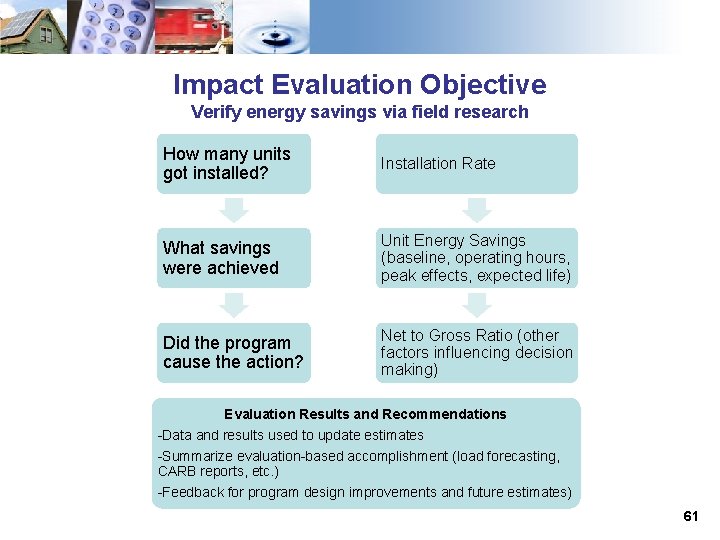
Impact Evaluation Objective Verify energy savings via field research How many units got installed? Installation Rate What savings were achieved Unit Energy Savings (baseline, operating hours, peak effects, expected life) Did the program cause the action? Net to Gross Ratio (other factors influencing decision making) Evaluation Results and Recommendations -Data and results used to update estimates -Summarize evaluation-based accomplishment (load forecasting, CARB reports, etc. ) -Feedback for program design improvements and future estimates) 61

Example Evaluation Based Updates in the 2006 -2008 Program Period The evaluation activities gathered new information from the field about actual field conditions and customer behavior. Based on evaluated results 70% of the electric savings goal was achieved Interactive Effects Installation Rate Net to Gross Unit Energy Savings -10% 0% 10% 20% 30% 40% 50% 60% -3% • Reduced heating needs due to improved efficiency 16% • Where and how blubs were installed 27% • The influence of the program, in capturing the savings 54% • What equipment was replaced and the hours of use Portion of change in savings claim attributable to evaluation findings 62

New Approaches to EM&V Administration New Approaches • EM&V Work Plan and Long Term Research Plans – a living document developed in close collaboration with IOUs • Evaluation needs integrated efficiently into multi faceted studies • Studies implemented on staged, rolling basis • Stakeholder input scheduled including dispute resolution structure • Prime contractor administrative structure to ensure consistency across sampling methodologies , identify study synergies, eliminate redundancy 63

Evaluation Driven Changes to EE Programs 64

Strategic Plan 65

California Long-Term Energy Efficiency Strategic Plan 2007 2008 2009 2013 • CPUC adopts Big Bold Energy Efficiency Strategies • CPUC orders a Strategic Plan to achieve “all cost-effective energy efficiency. ” • CPUC adopts the Strategic Plan • CPUC approves IOU programs shaped by the Strategic Plan • Strategic Plan update process begins 66

Strategic Plan Implementation Vehicles IOU Portfolios State Agencies Action Plans Big Bold Energy Efficiency Strategies Champions Network Foundation Grants 67

Action Plans: A Project Management Tool for Strategic Plan Implementation 68

Action Plan Example • • • Strategy 1 -3: Establish “Path to Zero” Campaign to Create Demand for High. Efficiency Buildings 1 -3 -2 Organize forums to develop and exchange experience and data on emerging technologies, practices, and designs that deliver ultra-low and ZNE buildings Champions: Peter Turnbull (PG&E), Gregg Ander (SCE), RK Stewart (Perkins & Will) Complete -Convene regular forums involving key market actors, technical experts Q 3 2010 -Record and inventory data and related emerging tech at forums, and publish on-line -Survey forum participants re: best information for owners, architects Q 4 2010 -Coordinate forums with “Lead By Example” efforts (Strategy 2 -1) -Identify and craft ZNE best practices and technical guides; create a ZNE Mentorship program - 69
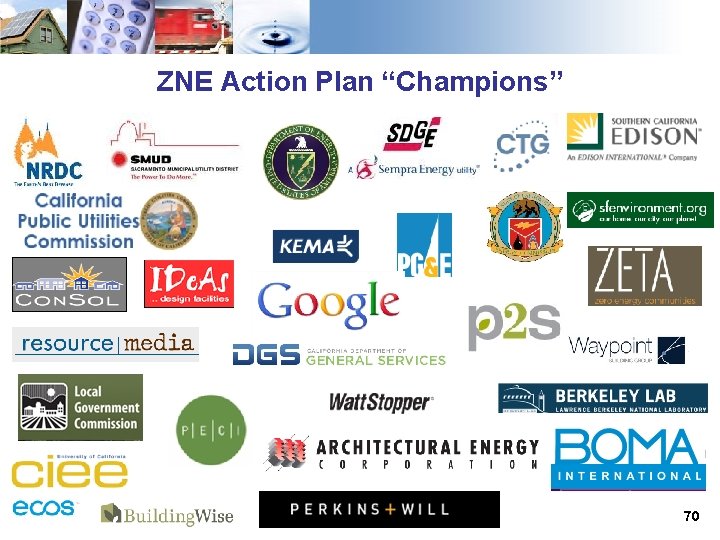
ZNE Action Plan “Champions” 70

Actions Plans Developed / Underway Completed • • Commercial ZNE HVAC (currently being updated) Lighting Research & Technologies (Co-led or led by Energy Commission) • Codes & Standards (Co-led or led by Energy Commission) Underway • Local Government • Industrial • Residential ZNE 71

Energy Division Organizational Chart and Staffing 72
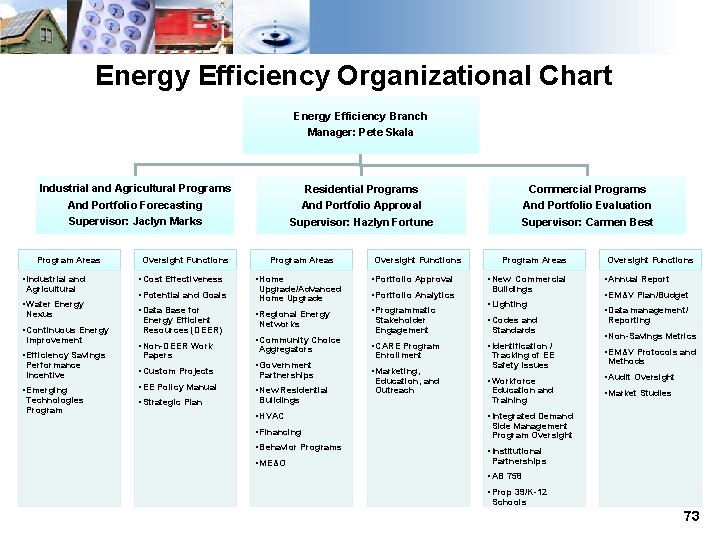
Energy Efficiency Organizational Chart Energy Efficiency Branch Manager: Pete Skala Industrial and Agricultural Programs Residential Programs Commercial Programs And Portfolio Forecasting Supervisor: Jaclyn Marks And Portfolio Approval Supervisor: Hazlyn Fortune And Portfolio Evaluation Supervisor: Carmen Best Program Areas • Industrial and Agricultural • Water Energy Nexus • Continuous Energy Improvement • Efficiency Savings Performance Incentive • Emerging Technologies Program Oversight Functions • Cost Effectiveness • Potential and Goals • Data Base for Energy Efficient Resources (DEER) • Non-DEER Work Papers • Custom Projects • EE Policy Manual • Strategic Plan Program Areas • Home Upgrade/Advanced Home Upgrade • Regional Energy Networks • Community Choice Aggregators • Government Partnerships • New Residential Buildings • HVAC • Financing • Behavior Programs • ME&O Oversight Functions • Portfolio Approval • Portfolio Analytics • Programmatic Stakeholder Engagement • CARE Program Enrollment • Marketing, Education, and Outreach Program Areas • New Commercial Buildings • Lighting • Codes and Standards • Identification / Tracking of EE Safety Issues • Workforce Education and Training Oversight Functions • Annual Report • EM&V Plan/Budget • Data management/ Reporting • Non-Savings Metrics • EM&V Protocols and Methods • Audit Oversight • Market Studies • Integrated Demand Side Management Program Oversight • Institutional Partnerships • AB 758 • Prop 39/K-12 Schools 73

Thank You More information: http: //www. cpuc. ca. gov/PUC/energy/Energy+Efficiency/ 74

Appendices • New OIR • Regulatory History of EE • 2013 -14 EE Program Details 75

New OIR Scope • Phase 1: 2015 Funding, with targeted changes o Prop 39 Support o SONGS Responses o Home Upgrade Programs o Water-Energy • Phase 2: “Rolling Portfolio Cycles” • Phase 3: Broader portfolio changes for 2016+ and Strategic Plan update 76
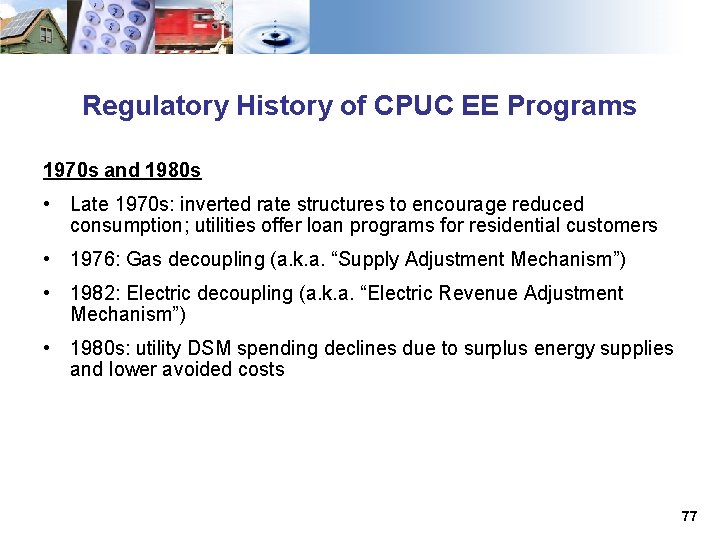
Regulatory History of CPUC EE Programs 1970 s and 1980 s • Late 1970 s: inverted rate structures to encourage reduced consumption; utilities offer loan programs for residential customers • 1976: Gas decoupling (a. k. a. “Supply Adjustment Mechanism”) • 1982: Electric decoupling (a. k. a. “Electric Revenue Adjustment Mechanism”) • 1980 s: utility DSM spending declines due to surplus energy supplies and lower avoided costs 77
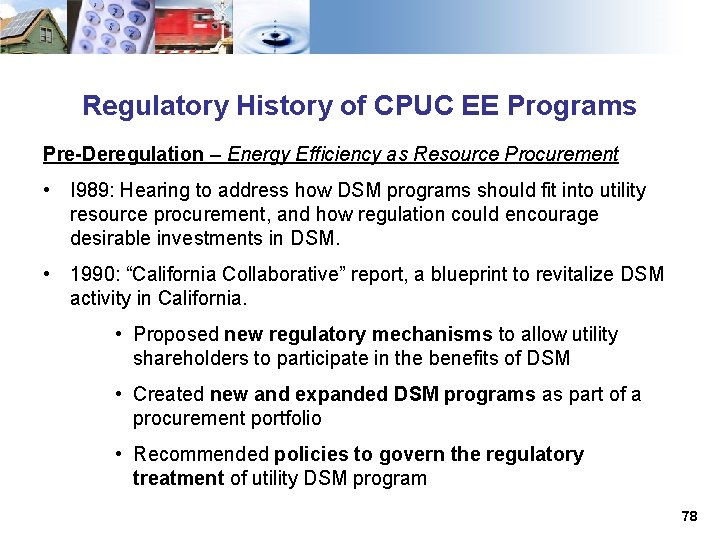
Regulatory History of CPUC EE Programs Pre-Deregulation – Energy Efficiency as Resource Procurement • I 989: Hearing to address how DSM programs should fit into utility resource procurement, and how regulation could encourage desirable investments in DSM. • 1990: “California Collaborative” report, a blueprint to revitalize DSM activity in California. • Proposed new regulatory mechanisms to allow utility shareholders to participate in the benefits of DSM • Created new and expanded DSM programs as part of a procurement portfolio • Recommended policies to govern the regulatory treatment of utility DSM program 78
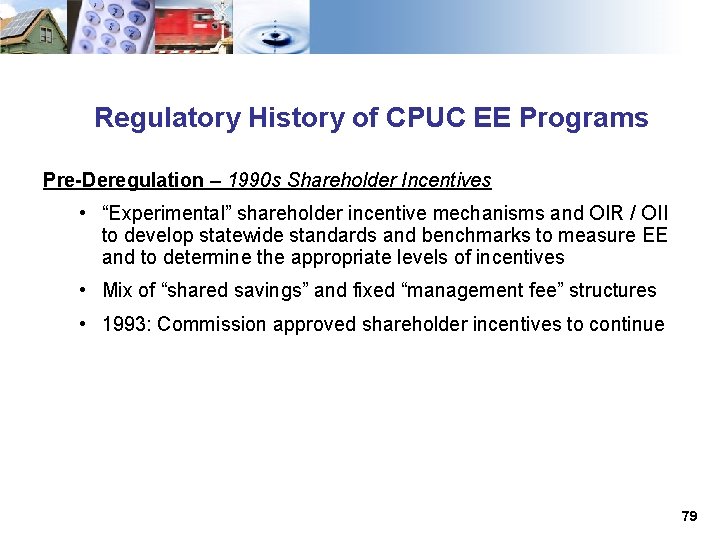
Regulatory History of CPUC EE Programs Pre-Deregulation – 1990 s Shareholder Incentives • “Experimental” shareholder incentive mechanisms and OIR / OII to develop statewide standards and benchmarks to measure EE and to determine the appropriate levels of incentives • Mix of “shared savings” and fixed “management fee” structures • 1993: Commission approved shareholder incentives to continue 79

Regulatory History of CPUC EE Programs Pre-Deregulation – Measurement and Evaluation • In 1993 the Commission established measurement and evaluation (M&E) protocols for measuring energy savings after program implementation • Utility shareholder earnings directly linked to the results of program measurement and evaluation • The adopted protocols required utilities to conduct M&E studies along a predetermined schedule over a 10 year period • Beginning in 1994, earnings would be paid out over a 10 year period, in four installments coinciding with study completion • Each installment would be dependent on study results designed to true-up the real benefits 80

Regulatory History of CPUC EE Programs Deregulation – Market Transformation, Independent Administration, and CBEE • In 1997, with the advent of electric restructuring and a shift towards market-based energy services, the Commission: – Began to shift from energy efficiency resource procurement to market transformation – Announced its intention to move administration of energy efficiency programs from the utility companies to an independent entity through a completive solicitation – Appointed an independent board, the California Board for Energy Efficiency (CBEE), to oversee the transition to independent administration 81
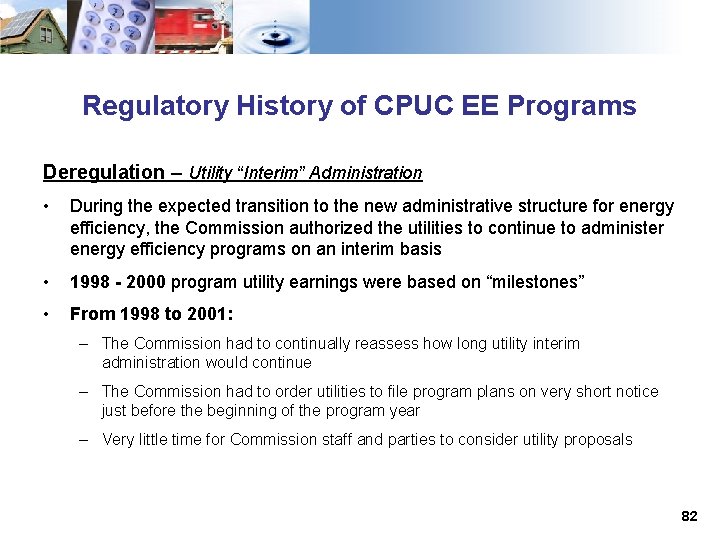
Regulatory History of CPUC EE Programs Deregulation – Utility “Interim” Administration • During the expected transition to the new administrative structure for energy efficiency, the Commission authorized the utilities to continue to administer energy efficiency programs on an interim basis • 1998 - 2000 program utility earnings were based on “milestones” • From 1998 to 2001: – The Commission had to continually reassess how long utility interim administration would continue – The Commission had to order utilities to file program plans on very short notice just before the beginning of the program year – Very little time for Commission staff and parties to consider utility proposals 82

Regulatory History of CPUC EE Programs Deregulation – Demise of CBEE • In 1998, the State Personnel Board disapproves of agreements between CBEE and its technical and administrative consultants in response to a complaint by CSEA • CBEE consultants were instructed to cease work and CBEE (a volunteer board) was left with insufficient resources • The Commission agreed to take steps to create nine civil service positions to perform the work previously performed by the CBEE consultants • Governor vetoes budget request for civil service positions • Commission abolishes CBEE in early 2000 83

Regulatory History of CPUC EE Programs Post -Deregulation – Energy Crisis / CPUC administration of EE programs • 2000: Commission responds to the energy crisis by adopting the Summer Initiative programs to run in parallel with the utility PGC programs – allocating $72 million in unspent funds from prior years – The Commission allowed non-utilities to propose programs – Energy Division staff selected programs • 2001: Legislature recognizes the importance of energy efficiency in addressing the energy crisis by appropriating $97 million from General Fund to the Commission for energy efficiency programs in SBX 1 -5 – Energy Division staff managed contracts with large and small utilities, cities and companies • 2002 -2003: Commission made $104 million available to non-utility programs – Continued the process of Energy Division proposal review and program management of non-utility programs begun by the Summer Initiative and SBX 1 -5 84

2013 -14 EE Portfolio 85
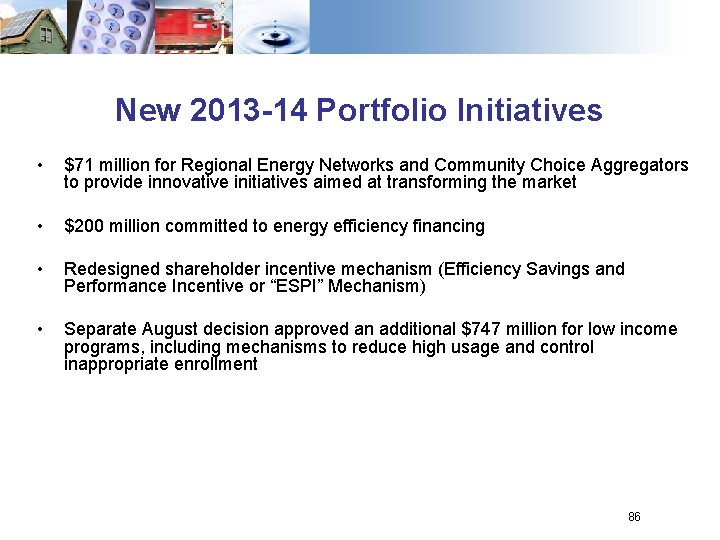
New 2013 -14 Portfolio Initiatives • $71 million for Regional Energy Networks and Community Choice Aggregators to provide innovative initiatives aimed at transforming the market • $200 million committed to energy efficiency financing • Redesigned shareholder incentive mechanism (Efficiency Savings and Performance Incentive or “ESPI” Mechanism) • Separate August decision approved an additional $747 million for low income programs, including mechanisms to reduce high usage and control inappropriate enrollment 86

Residential Buildings • 8 Subprograms: – Appliances rebate program • Single-family and Multi-family dwellings – Basic CFL and Advanced lighting “upstream” buy-downs – Electronics “up/mid- stream” buy-downs – Home energy use survey & tools (home energy reports, online, by phone, in person) – Energy Upgrade California- comprehensive home energy improvement program • Additional Third-Party and Local utility programs – e. g. Online Buyers Guide (SCE) • 18% of planned electric savings, 15% of gas savings, and 22% of portfolio budget 87

Whole-house Retrofit Subprogram • Energy Upgrade California Home Upgrade – Advanced Home Upgrade (performance) and Home Upgrade (Flexible) paths • Incentives; some marketing & outreach – Target for 22, 000 homes upgraded in 2013 -14 – New Home Upgrade path looks to give the customer a more flexible lower cost project than the Advanced Home Upgrade path – So. Cal. REN and Bay. REN will be acting as program implementers running Home Upgrade with ratepayer funds 88

Commercial Buildings • 5 Statewide programs – Non-Residential Audits – Deemed Incentives – Calculated Incentives – Continuous Energy Improvement – Direct Install • Local utility programs • Third-party administered programs – Targeting hospitals, lodging, schools, office buildings and various other niche markets • 23% of planned electric savings, 18% of gas savings, and 22% of portfolio budget 89

HVAC Programs • 5 Statewide Programs: – Commercial Quality Installation – Energy Star Residential Quality Installation – Residential Quality Maintenance – Commercial Upstream Distributor Rebate • Third Party Programs and Proposed Pilot Programs: – Air. Care Plus (PG&E) and Premium Efficiency Cooling (SDG&E) – Residential Upstream Distributor Rebate and Residential to Code Rebate 90

Codes & Standards Program • Analysis /Support activities – Principal audience is CEC’s building and appliance standards. – Also influences federal appliance standards via DOE proceedings and the legislative process • Major program activities: – Codes and Standards Enhancement (CASE) studies – Compliance Enhancement – “Reach Codes” – Planning and Coordination • 22% of planned electric savings, 25% of gas savings, and 1% of portfolio budget* *Savings based on 2010 -2012 cycle, non-verified. 91
- Slides: 91